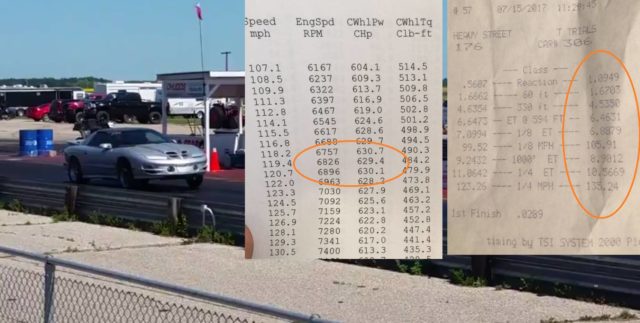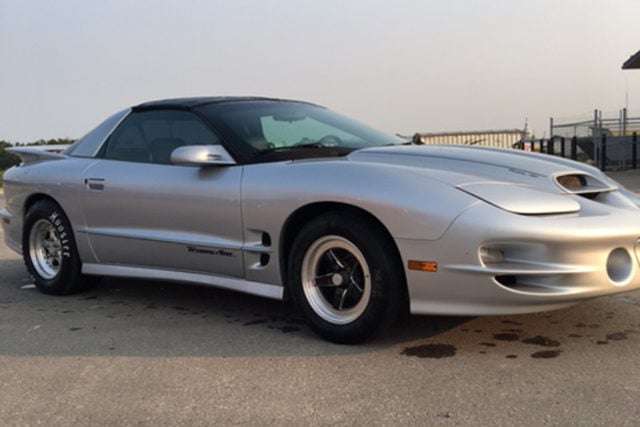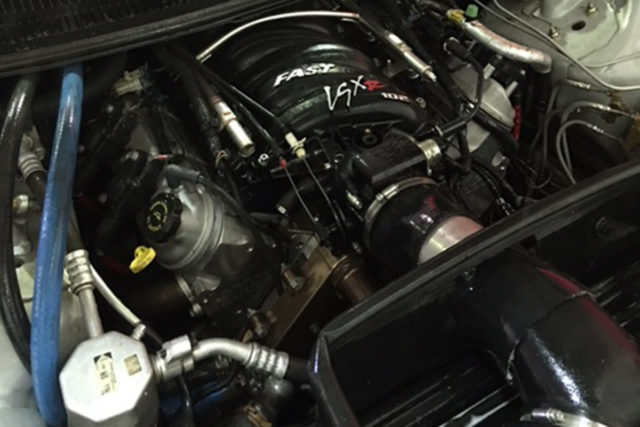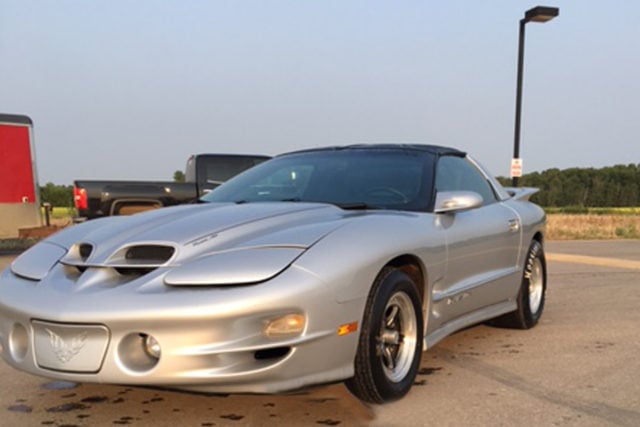You’ve heard it a thousand times. “There’s no replacement for displacement.” The only problem with that old adage is that, while being somewhat true, it doesn’t take into account a well-put together combo. Throwing a bunch of random parts at a large-cube motor won’t necessarily ensure that you’ll make massive amounts of power. What’s more impressive to us is doing more with less. And that’s exactly what Tyler Lee did with his 2002 Pontiac Trans Am.
Most of us are pretty familiar with standard stroker combinations like the 408, 416, and 427, but what do you do if you’d rather not increase the stroke but you want more cubes? You punch it out, that’s what. And that’s exactly what Tyler did, turning his 376 cubic inch LS3 into a fire-breathing 388.
Tyler’s story starts like many before it. He’s owned his Trans Am for over 10 years and originally didn’t plan on modifying the car at all. But after his first modification to the car, Pandora’s box was opened. After that, modifying the stock LS1 was enough to sate him, at least for a while. But when the LS1 wiped out a lifter about a year ago, the flood gates were opened.
Big Changes
“It wasn’t a big deal, just a cam and lifters, not that hard,” Tyler said. “But then I got looking on the classifieds and came across a used LS3. I thought ‘well, maybe I’ll just put that in instead.’ So I got that and was thinking ‘I might as well put a cam in it while it’s out.’”
This set in motion a chain of events that would make Tyler’s setup one of the most potent naturally aspirated street-going combinations we’ve seen in a while. For the cam, he turned to the guys at Cam Motion. He knew he wanted to spin the new motor pretty high and thought a solid lifter cam might be in order, and the guys at Cam Motion agreed. They spec’d him an LLR bump stick that measures in at 239 and 253 degrees of duration on the intake and exhaust lobe respectively with a max lift of .680-inch, all built on a 112 degree separation angle—a healthy cam to be sure.
Knowing that the heads had to be removed to replace the lifters, Tyler started thinking about improving the heads while he was at it as well. “I got looking at the GMPP LS3 heads, but really for what I’m doing, I thought the ports were a little too big,” Tyler explained. “Don’t get me wrong, they’re great, but for a motor that size you’d have to go 8-8,500+ rpm and it’s my street car so I wanted it to be more in the 7,500-rpm range.”
This got Tyler looking at a set of Mast Motorsports medium bore heads. They retain virtually the stock LS3 port volume while flowing considerably more air, making them the perfect fit for Tyler’s build. He selected a Fast 102mm intake, with medium-length runners, to feed the heads. However, after removing the stock heads, it was discovered that the cylinders on LS3 were scored and would need a bore to get them smooth again. This took the build in a completely different direct yet again. Since Tyler wanted to do a big-bore, small-stroke combination, he located an LS7 block for his build and put the LS3 on hold.
Since the engine would now be built from the ground up, Tyler felt it was a good time to move to some upgraded pistons and connecting rods. He selected a set of forged Mahle slugs and forged connecting rods.
388
“I got looking and said ‘you know what? I’ve always wanted a 388,’” Tyler reminisced. “Basically the LS7 bore with the LS3 crank. The big bore just works really well in a two-valve wedge setup.”
Being that the engine would be a somewhat unusual combination, Tyler set out to find an engine builder that could competently complete the setup. He found Shwanke Racing Engines out of Springfield, Minnesota who had experience building 388 setups. And though they had experience building 388s, even they tried to persuade Tyler into building a 416.
“They tried to talk me into a 416 with the original LS3, which I totally get and understand the point, it’s a cheaper, easier way to get cubic inches,” Tyler explained. “But I didn’t want a 4-inch stroke, I wanted to stick with the LS3 crank.”
After the specs of the engine were set, Tyler says Shwanke did a great job building the 388 and had it back to him in no time. After the short-block was back in his possession, Tyler finished off the long-block over the course of a couple of months and got the engine back in the car. He used T&D rockers to tickle the valves and a set of 2-inch Texas-Speed headers backed by a Speed Engineering 3-inch dual exhaust to handle spent gases. And while Tyler admits he is a novice tuner, he handled the tuning duties himself with HP Tuners and a little help from the forum over at LS1tech.com.
Dyno-mite
With the combo up and running, he headed to Motion Performance to get the car on the dyno for final tuning and power numbers.
“I went with Motion because his dyno is known for being really accurate, bordering on a heart-breaker, and I didn’t want anyone crying foul over the numbers,” Tyler said. “I was hoping best case it would make 590-600. At first, the guys asked what was done to it and I told them ‘basically an LS3 with cam, heads, and intake’ so they look at me and say ‘oh, so probably 450-460 at the tires.’ I just laughed and said ‘yeah, maybe. I don’t know.’”
When the dyno operator saw the Mast heads, he amended his guys to 500+ at the tires. But what the car actually put down astonished both Tyler and the dyno tech. The first pull resulted in 591 horsepower at the rear wheels. After looking at the logs from the run, Tyler decided to add in a little more timing up top. After dialing in three degrees more timing, the car manage to put down 630 horsepower to the rear tire. Astonishing power numbers to be sure.
However, Tyler admits that the numbers weren’t accomplished on 100 percent pump gas. He credits his own secret blend of fuel for such monstrous numbers—we call it Tyler’s secret recipe. The engine’s compression comes in at 11.5:1, not outside the realm of operating safely on pump gas, but obviously the additional timing allowed by the “secret sauce” paid off in spades.
Track bound
Though Tyler was thrilled by the numbers, he knew the real test was on the track. He headed to his local track to find out what the Trans Am had in it. When he arrived, he was informed that the first 100 feet of the track had just been repaved the day before and wasn’t exactly optimized for traction at the moment. Undeterred, Tyler headed to the starting line.
Since Tyler’s 388 is backed by a T56, coupled by a SPEC Mini-Twin, the launch would make or break his runs. Power is routed to a Moser 9-inch rear end housing 4.56 gears and turning 28-inch tall Hoosier bias plys. Still, Tyler was only making eight-mile passes before shutting the car down for fear of being kicked out by the track.
“The manager came over and was like, ‘why are you hitting the breaks at the eighth-mile?’” Tyler said. “I was like, ‘I just swapped out a bolt-on LS1, so I’m worried about needing a cage.’ He just laughed and told me to go for it and that he’d give me a couple runs to see what it could do.”
With the green light from the track, Tyler pulled to the line after heating the tires. He describes the launch as “decent” but went on to run 10.56 at 135 mph on what essential was a shakedown run. After which, Tyler says the track manager promptly tracked him down and told him that he should cool it.
Tyler accredits the cars stout power and track numbers to his focus on increasing drivetrain efficiency rather than the overall power production of the engine, but anyway you look at it, this thing is fast. Would it have been faster with more cubic inches? Who knows, but seeing as how this car likely has a naturally aspirated 9-second pass in it, who’s counting?























